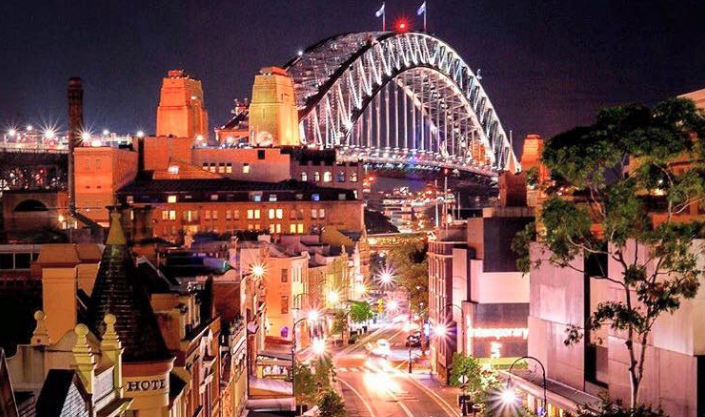7 major takeaways from Global Cities After Dark in Sydney

With all indications that Sydney’s lockouts will be confined to the scrapheap of history by 2020, the day-long Global Cities After Dark Sydney (Friday 15) looked with great excitement and focus at the city’s future was a 24-hour destination.
The discussions covered challenges and solutions to a wide range of issues, and broke them up into three key timelines including one year, five years and 10 years post-lockouts.
They were framed by three themes – content and culture; creative space & city planning; and policy/framework and education
These were seven takeaways from the forum:
1. North Alexandria the new nightlife zone
Eradicating the “culture of complaint” is already in sway. But one way to overcome noise complaints is to find warehouse precincts that can create an atmosphere without disrupting residents.
The City of Sydney identified North Alexandria as expressed by the lord mayor of Sydney, Clover Moore, and Cr Jess Scully.
Moore opened the day’s proceedings, noting the effects of the last few years, before reinforcing her commitment to making positive change.
“The lockouts have been a real blow to our city but the repeal will breathe life back into Sydney.”
The late-night trading development control plan is a central tool in the process. The DCP is ‘the map of fun’ to reverse the negative impact of pokies, big-screen TVs and lockouts.
Scully’s vision is to have a large scale club space in North Alexandria by 2020.
The 15-member City of Sydney Nightlife and Creative and Advisory Panel also recognised the adverse impact of urban sound/noise complaints on a venue.
It has a plan in motion to address this as well as five other key priorities for the year ahead.
According to a report in TMN, these are to change the narrative about Sydney’s nightlife reduce regulation promote stronger collaboration among stakeholders; deliver flexible buildings to enable more creativity; and advocate for the introduction of 24-hour public transport.
2. Be part of the drive to make bureaucracies creative
Music fans, businesses and others should be prepared to work at changing the culture of bureaucracies from a ‘No, because’ to a ‘Yes, if’ so they can become more creative.
International author, speaker and the founder of the Creative Cities Index, Oxf0rd, England-based Charles Landry, believes clubs and the night often prefigure futures in making alternative cities.
It is essential, in making a city a cultural and nightlife centre, to also making it aesthetically and environmentally pleasing.
That means interacting with bureaucracies and making sure they are as modern-thinking as they should be and open to changes.
Bureaucracies in Europe and the US are modernising, and trying to eliminate waste of time and money, and engaging citizens so that they maximise their potential and elevate their energy.
Among these examples of other international cities doing things differently to Sydney was Berlin, whose open-ended nightlife is 71-years-old.
For Landry, ‘creative bureaucracy’ are two words seemingly in tension, no matter where you are, but with so much potential.
His observations are that policymakers the world over “employ bright people but through years of training, they conform to the system, but in their private life they are a new world”.
In other words, Sydney’s citizens and businesses must be prepared to drive the change and to contribute.
3. Mend the disconnect with government
Ben Van Houten, San Francisco’s business development manager for the nightlife and entertainment sector, said, “It’s incumbent on cities to positively engage with nightlife.
“There’s an incredible knowledge gap between government and those who actually go out: there’s often a disconnect that we can resolve.
“Educating lawmakers on what nightlife and nightlife work actually looks like. governments can’t plan for nighttime activity if they don’t understand it.”
But with a global trend in nightlife spaces being eradicated to make way for residential demand an important question raised was – how do we protect nightlife spaces from redevelopment and how do we integrate nightlife into planning processes?
4. One Year Plan
As part of interactive workshops, the Global Cities After Dark audience collaborated on future solutions for the city.
One-Year plan: there needs to be an optimistic and open way forward, open and proud – how to make Sydneysiders proud and make the media message more about improved cultural life after lockouts, and not just more drinking hours?
5. Five Year Plan
Culture mapping will be key to championing the stories and people behind them in the various communities that make Sydney what it is.
A micro and macro plan for Sydney and what it represents to people on a local and international scale, should be decided upon and amplified accordingly.
Vibrancy will be actively encouraged and accessibility for artists and creatives will be made possible with semi-permanent structures and a government committed to unconventional night time activities.
6. 10 Year Plan
With increasing digital engagement, public space will be taken back and used to build a sense of community and inclusiveness, to avoid people in apartments suffering from isolation.
With more flexible working opportunities and no more 9-5 culture, the point was repeatedly made through the day that Sydney will maintain its credentials as a creative and artistic hub with 24-hour accessibility, to prevent it becoming a victim to domestic migration of Wollongong and Newcastle
7. Solving the drug problem
Sydney and Australia are in a political stand-off on how to best approach drug education and harm minimisation without the hysteria and statistics-shuffling that continues to accompany these discussions
The hypothetical at Global Cities After Dark brought together people from all sides of the fence to try and forge a way forward.
Dr Mary Harrod, head of the NSW Users and AIDS Association (NUAA) on not using all the options: “Because there’s been a block on research and development on pill testing, we’re not using all the social levers available to solve this problem.”
Judith Norijen, senior prevention manager, Jelinek, on how Amsterdam faced the challenge a decade ago: “it’s not easy, but it is achievable:
“It took 10 years to get to progressive drug policies in Amsterdam – bridging differences and agreeing on responsibilities.”
Dr Alex Woda on numbers on the wider health issues at large: “There are 20,000 smoking-related deaths in Australia per year, a number greater than alcohol, prescription and illicit drug deaths in a year combined.”
Adelle Robinson from Fuzzy Operations on widening discussions: “Destigmatising drug use is paramount – so doctors, schools and parents are open to the conversation.”
Other speakers included the Australian Hotels’ Association’s John Green; detective superintendent Stacey Maloney from NSW Police; Art Pharmacy’s Emilya Colliver; James Winter from Brand X; Night Time Industries Association’s Michael Rodrigues; Left Bank Co’s Michelle Tabet and Property Council’s Will Power.
Global Cities After Dark Sydney was presented by the Electronic Music Conference (EMC) & VibeLab and supported by the NSW Government through Create NSW, the City of Sydney and The Ticket Fairy.

































